CD49b antibody | AK7

Mouse anti Human CD49b
- Product Type
- Monoclonal Antibody
- Clone
- AK7
- Isotype
- IgG1
- Specificity
- CD49b
| Mouse anti Human CD49b antibody, clone AK7 recognizes the integrin alpha 2 subunit, a ~160 kDa glycoprotein that non-covalently associates with the ~130 kDa integrin beta 1 subunit to form the VLA-2 complex. CD49b is expressed by platelets, long term cultivated T cells, approximately 50% of monocytes and most adherent cell lines. Mouse anti Human CD49b antibody, clone AK7 inhibits cell attachment to collagen. |
- Target Species
- Human
- Species Cross-Reactivity
-
Target Species Cross Reactivity Cynomolgus monkey Rhesus Monkey Baboon - N.B. Antibody reactivity and working conditions may vary between species.
- Product Form
- Purified IgG - liquid
- Preparation
- Purified IgG prepared by affinity chromatography on Protein A from tissue culture supernatant
- Buffer Solution
- Phosphate buffered saline
- Preservative Stabilisers
0.09% Sodium Azide - Carrier Free
- Yes
- Approx. Protein Concentrations
- IgG concentration 1.0 mg/ml
- Fusion Partners
- Spleen cells from immunised mice were fused with cells of the mouse NS1 myeloma cell line.
- Regulatory
- For research purposes only
- Guarantee
- 12 months from date of despatch
Avoid repeated freezing and thawing as this may denature the antibody. Storage in frost-free freezers is not recommended.
| Application Name | Verified | Min Dilution | Max Dilution |
|---|---|---|---|
| Flow Cytometry | 1/50 | 1/100 | |
| Functional Assays 1 | |||
| Immunohistology - Frozen 2 | 1/500 | 1/1000 | |
| Immunohistology - Paraffin |
- 1 Clone AK7 has been reported to work in functional assays, Bio-Rad recommend the use of MCA743EL for this purpose.
- 2The epitope recognised by this antibody is reported to be sensitive to formaldehyde fixation and tissue processing. Bio-Rad recommends the use of acetone fixation for frozen sections.
- Flow Cytometry
- Use 10ul of the suggested working dilution to label 106 cells in 100ul.
- Histology Positive Control Tissue
- Tonsil
| Description | Product Code | Applications | Pack Size | List Price | Your Price | Quantity | |
|---|---|---|---|---|---|---|---|
| Mouse IgG1 Negative Control | MCA928 | F | 100 Tests |
|
Log in | ||
| List Price | Your Price | ||||||
|
|
Log in | ||||||
| Description | Mouse IgG1 Negative Control | ||||||
References for CD49b antibody
-
Favaloro, E.J. et al. (1990) Co-expression of haemopoietic antigens on vascular endothelial cells: a detailed phenotypic analysis.
Br J Haematol. 74 (4): 385-94. -
Mazurov, A.V. et al. (1991) A monoclonal antibody, VM64, reacts with a 130 kDa glycoprotein common to platelets and endothelial cells: heterogeneity in antibody binding to human aortic endothelial cells.
Thromb Haemost. 66 (4): 494-9. -
Cavers, M. et al. (2002) Differential expression of beta1 and beta2 integrins and L-selectin on CD4+ and CD8+ T lymphocytes in human blood: comparative analysis between isolated cells, whole blood samples and cryopreserved preparations.
Clin Exp Immunol. 127: 60-5. -
Koutsogiannaki, S. & Kaloyianni, M. (2011) Effect of 17β-estradiol on adhesion of Mytilus galloprovincialis hemocytes to selected substrates. Role of alpha2 integrin subunit.
Fish Shellfish Immunol. 31 (1): 73-80. -
Hamaia, S.W. et al. (2012) Mapping of potent and specific binding motifs, GLOGEN and GVOGEA, for integrin α1β1 using collagen toolkits II and III.
J Biol Chem. 287 (31): 26019-28. -
Mörtberg A et al. (2016) Sensitive detection of platelet-specific antibodies with a modified MAIPA using biotinylated antibodies and streptavidin-coated beads.
J Immunol Methods. 434: 9-15. -
Rane, J.K. et al. (2016) Inhibition of the glucocorticoid receptor results in an enhanced miR-99a/100-mediated radiation response in stem-like cells from human prostate cancers.
Oncotarget. 7 (32): 51965-80. -
García-gareta, E. et al. (2019) Engineering the migration and attachment behaviour of primary dermal fibroblasts.
Biotechnol Bioeng. Jan 19 [Epub ahead of print].
View The Latest Product References
- Synonyms
- Integrin Alpha 2 Chain
- VLA-2
- RRID
- AB_321446
- UniProt
- P17301
- Entrez Gene
- ITGA2
- GO Terms
- GO:0007596 blood coagulation
- GO:0004872 receptor activity
- GO:0005518 collagen binding
- GO:0008305 integrin complex
- GO:0007160 cell-matrix adhesion
- GO:0007229 integrin-mediated signaling pathway
- GO:0007411 axon guidance
- GO:0042802 identical protein binding
- GO:0044419 interspecies interaction between organisms
- View More GO Terms
Please Note: All Products are "FOR RESEARCH PURPOSES ONLY"
View all Anti-Human ProductsAlways be the first to know.
When we launch new products and resources to help you achieve more in the lab.
Yes, sign me up